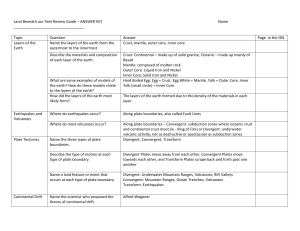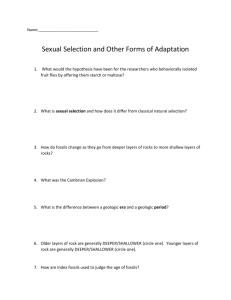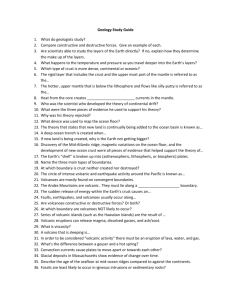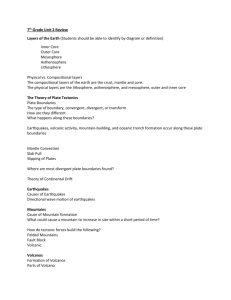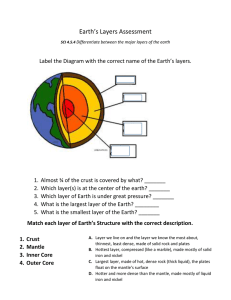The Changing Earth Review
advertisement
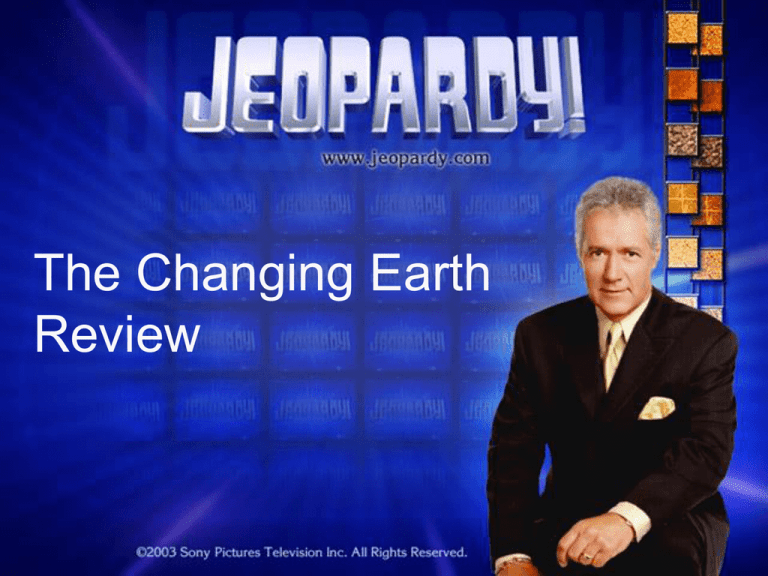
The Changing Earth Review Double Jeopardy Jeopardy Round 1 Layers of More Plate More Volcanoes the Earth Layers Movement Movement & Quakes 100 100 100 100 100 200 200 200 200 200 300 300 300 300 300 400 400 400 400 400 500 500 500 500 500 More Layers $100 Answer: Scientific evidence indicates the Earth is made of this many basic layers. What is 4? More Layers $200 Answer: This layer surrounds the Earth like a shell or skin. What is the crust? More Layers $300 Answer: This layer is found at the very center of the Earth and is shaped like a sphere. What is the inner core? More Layers $400 Answer: Seismology is the study of this, which gives us a lot of information about the inner core. What are earthquakes? More Layers $500 Answer: Melted rock in the Earth’s mantle is called this. What is magma? Layers of the Earth $200 Answer: This is the thickest layer of the Earth. What is the mantle? Layers of the Earth $500 Answer: The inner core should be liquid, but it’s solid because of this from the other layers. What is pressure? Layers of the Earth $300 Answer: This layer of the Earth is made of molten iron and nickel. What is the outer core? Layers of the Earth $100 Answer: This is the thinnest and coldest layer of the Earth. What is the crust? Layers of the Earth $400 Answer: This layer of the Earth is made of solid iron and nickel. What is the inner core? Volcanoes & Earthquakes $100 Answer: The Ring of Fire is a chain of over 300 active volcanoes located in this ocean. What is the Pacific Ocean? Volcanoes & Earthquakes $200 Answer: Seismographs can detect energy released in these and can help predict volcanic eruptions. What are earthquakes? Volcanoes & Earthquakes $500 Answer: In the year 69, Mt. Vesuvius erupted and buried this Roman town. What is Pompeii? Volcanoes & Earthquakes $300 Answer: Though very rare, underwater earthquakes can cause these destructive ocean waves. What is tsunamis? Volcanoes & Earthquakes $400 Answer: This from volcanoes can be very dangerous to breathe, but will create very fertile soil. What is ash? Plate Movement $400 Answer: This theory suggests that plates move slowly about the Earth’s surface, driven by heat. What is the Continental Drift Theory? Plate Movement $300 Answer: At one time, the continents all formed one supercontinent, named this. What is Pangea? Plate Movement $500 Answer: These imprints or remains of once living things give us information about how life was in the past. What are fossils? Plate Movement $100 Answer: This type of energy within the Earth causes plates to move. • What is thermal (or heat) energy? Plate Movement $200 Answer: These are large continent-sized blocks of rock from the crust and upper mantle. • What are plates? More Movement $500 Answer: Mountains formed in the ocean are called these. What are midocean ridges? More Movement $300 Answer: This type of boundary occurs when plates move apart from each other. Volcanoes and midocean ridges often form here. What is divergent? More Movement $400 Answer: This type of boundary occurs with plates slide past one another. Earthquakes occur here. What is transform? More Movement $200 Answer: This type of boundary occurs when plates move together. Mountain ranges and trenches often form here. What is convergent? More Movement $100 Answer: These are breaks in the Earth’s crust that result from the ground shifting. What are faults? Final Jeopardy Double Jeopardy! Fossils Planets 200 200 400 400 600 600 800 800 1000 1000 Fossils $600 Answer: Fossils of dinosaur footprints were found in this region of Virginia. What is the Piedmont region? Fossils $800 Answer: Because of this reason, we know that the Appalachian Mountains were once warm, steamy, and swampy like the Florida Everglades. What is “because fossils of ferns were found in this region”? Fossils $1000 Answer: This region of Virginia was once covered by an ocean. We know this because of the fossils found here. What is the Coastal Plain/Tidewater region? Fossils $400 Answer: Bones and teeth from ancient ocean animals were found in this region of Virginia. What is the Coastal Plain/Tidewater region? Fossils $200 Answer: Fossils of ferns were found in this region of Virginia. What are the Appalachian Mountains? Planets $200 Answer: List the planets in order from closest to the sun to furthest. What is: Mercury, Venus, Earth, Mars, Jupiter, Saturn, Uranus, Neptune? Planets $400 Answer: The 4 planets are terrestrial. What are: Mars, Mercury, Venus, Earth? Planets $600 Answer: These 4 planets are gas giants. What are Jupiter, Uranus, Neptune, Saturn? Planets $800 • Answer: This is the largest planet. What is Jupiter? Planets $1000 Answer: This is a list of the planets in order from largest to smallest. What is: Jupiter, Saturn, Uranus, Neptune, Earth, Venus, Mars, Mercury? Final Jeopardy! Layers of the Earth Make your bid!! Draw a diagram of the 4 layers of the Earth. Label each layer. Tell what each layer is made of (For the inner and outer core – you must distinguish which one is solid and which one is made of molten material). The crust and mantle are made of rocky material. The outer core is made of molten iron and nickel. The inner core is made of solid iron and nickel.
